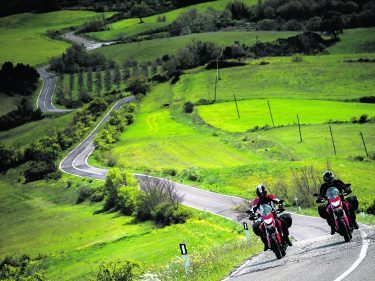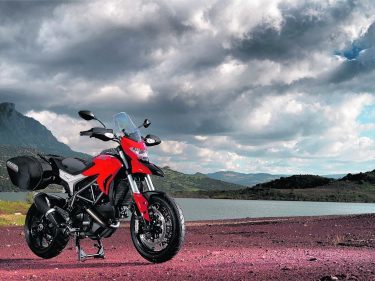Ducati’s Hypermotard is a hooligan’s bike. Simple as that. There is no point pretending anything else.
Long suspension, a tall, hard seat, an aggressive riding position and a (very) punchy twin cylinder engine.
Hence it’s name: Hyper (it certainly is) Motard – as in supermoto.
The Italians proved that a supermoto doesn’t need to be a single-cylinder to be successful. Now they’ve developed a tourer from the very same family.
The Hyperstrada has the same 821cc Testastretta 11-degree so-called “L-twin” as the Monster 821, the Hypermotard and the Hypermotard SP, producing 110bhp and 66lb/ft of torque. It is also loaded with electronics; ABS, DTC (Ducati Traction Control), DSP (Ducati Safety Pack) and three riding modes. Sport and Touring have 110bhp; Urban is reduced to 75bhp, presumably for your own safety.

The factory-fitted panniers have 50 litres of storage capacity and although they look relatively modest in size, you can easily zip a full-face helmet into each. If packing light is an issue, the 31-litre top box, which is available as an extra, offers even more space.
Ducati have also adapted the Hypermotard’s riding position to make the Hyperstrada more comfortable for the longer journeys.
There are easy-to-reach grab handles for your passenger, two 12V sockets, the handlebars are 20mm higher, a “touring” windscreen has been added and both the pillion and rider’s bottoms should be well cushioned with the broader, padded seat which, at just 830mm, is much lower than the MV Agusta Stradale 800’s (870mm). A 20mm-lower version is also available as an accessory if you’re struggling on tippy toes.
The Hyperstrada is like a cross between a Hypermotard and a Multistrada. That strong engine and an agile chassis combined with some of the creature “comforts” of a tourer. But bear in mind that this is Italian, so don’t get carried away by its touring ability. It’s not German. Or Austrian. Or English.
It is huge fun though. So although it lacks what some might consider bare essentials for touring, like a centre stand, a fuel gauge (no, really, it doesn’t have one), a clock and a gear indicator, there is still a good chance that you’ll reach your destination with a smile on your face.
The Hyperstrada isn’t really a long-distance tourer, but it’s comfortable enough for a full day’s riding. It feels quite compact when you first climb on (if you’re a six-footer like me). There’s ample legroom and the windscreen offers adequate protection for legal limits, but you’ll still feel the wind blast on your shoulders and helmet.
The 53.5mpg fuel consumption is quite reasonable considering its pedigree and you could get more than 180 miles from the 16-litre tank. Compared to a rival like the thirsty (41mpg) MV Agusta Stradale 800, the Ducati is positively frugal.
It’s also £800 cheaper than the MV, and should you ever need to carry a pillion, they will be noticeably more comfortable on the Ducati than perched on the postage stamp-sized passenger seat of the Stradale.

The Hyperstrada’s handling is more neutral, too. It falls into corners without protesting but it’s not so sharp you’re at risk of cuts. The wide handlebars offer good leverage for side-to-side flicks and, once over, it holds its line well. The non-adjustable front forks and Sachs preload and rebound adjustable rear suspension don’t buck or wallow too much and although it won’t deck out on every bend, the ground clearance is a limiting factor.
With the absence of “hero blobs” hanging beneath the footpegs, there’s little warning when you’re about to reach maximum lean. The upside is that you can push the Hyperstrada just that little bit further. The potentially painful and expensive downside is that the brake and gear levers are the first to touch down, and the gear lever is inclined to bend under pressure.
As far as the riding modes go there are no surprises. They all do the job they’re supposed to do, although the Sport mode is a bit snatchy. The Touring mode seems the most user-friendly and rewarding and the engine has plenty of low-down grunt. Stopping power is like the rest of the bike’s performance; good without being eye-popping.
The Hyperstrada doesn’t have the comfort or reassurance of a fully-fledged tourer. It’s no sports bike, either. It’s tough to know what it is, really, but it does at least have way more to offer than a simple supermoto.
THE FACTS
Model: Ducati Hyperstrada
Price: From £10,795
Engine: 821cc V-twin producing 110bhp @ 9,250rpm and 66lb/ft @ 7,750rpm
Transmission: Six-speed sequential manual, chain drive
Weight (wet): 204kg
Seat Height: 830mm
Fuel Capacity: 16 litres
